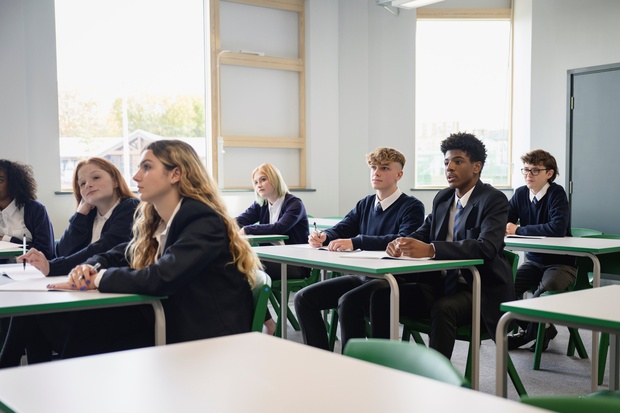Involving more than 1000 teachers, the national study, published by Collective Shout, a grassroots campaigns movement against the objectification of women and the sexualisation of girls, in partnership with parenting author and educator Maggie Dent found sexual harassment cast at female teachers was ‘widespread, entrenched and normalised’.
Reports of being propositioned, threatened with rape, subjected to sexist slurs and children mimicking pornographic sex acts in class emerged from teachers’ accounts.
Educators said they had been moaned, groaned, and grunted at, asked for nudes and intimidated while on campus.
Almost 80 per cent of teachers reported a rise of damaging sexual behaviours in their schools, with many female teachers saying they did not feel safe at work.
Huge gaps in school policies, procedures and codes of conduct around student-to-teacher sexual harassment were flagged.
Teachers are also having to grapple with ‘multiple disclosures’ from student victims, including girls in Years 5 and 6 who have been coerced into sending sexually explicit images, the study found.
In some instances, teachers reported children as young as Year 2 were accessing and sharing pornographic content through their own personal devices or social media.
The influence of online pornography and social media figures were among the key drivers of the problem, teachers said.
We spoke with Melinda Tankard Reist, movement director at Collective Shout, about the findings.
SD: Hi Melinda. This survey has unearthed some disturbing findings and you’re now saying that schools have become ‘sites of sexual abuse’ for many female teachers. Can you outline the situation for us, as you understand it?
MTR: What’s going on is that female teachers are being routinely sexually harassed in schools, primarily by male students and primarily by adolescent boys in Years 9 and 10.
We knew there was a problem already, because I'm in schools most days and have increasing numbers of female teachers and female students telling me about being touched, being sexually harassed, being propositioned, being threatened with rape, being subjected to disgusting comments about their bodies, being sexually groaned and moaned at.
Maggie Dent and I both knew that was a problem, but this survey shows it is just rampant, widespread, entrenched and normalised.
And as [the study found], some of the reports are related to kids as young as Kindergarten to Year 3, where they’re asking for nudes, grunting, groaning, moaning.
So, this is why we’ve described it as a crisis, and this is why I said schools are a site of abuse and for harmful sexual behaviourrs, which are on the rise.
To what extent are these behaviours being fuelled by students’ access to social media and devices while at school?
That is certainly covered in our report. The access to devices and phones at schools, access to pornography, was identified by a significant number of teachers as a driver of harmful sexual behaviours and sexual harassment.
Teachers identified that these behaviours had become worse in the last few years. One of the findings was that children as young as Year 2 were accessing and sharing pornographic content through their devices and social media.
Another finding was that girls in Years 5 and 6 were being coerced into sending sexual images. So, pornography has groomed boys to act in these highly inappropriate ways.
Pornography is our biggest department of education in the world, and we’re seeing the results of that playing out in our schools every day with female teachers and female students subjected to porn-inspired sexual harassment.
Another finding that stood out to me was that many teachers were saying they weren’t really supported, either by school policy or leadership, to address instances of sexual harassment from students. Can you tell us more about this?
Many teachers reported feeling unsupported in their workplaces. They didn’t feel safe at work. They were dealing with increased numbers of disclosures from female students, but when they reported (these) they felt that the issues weren’t taken seriously, that they were dismissed, they were told it was just ‘boys will be boys’, or they were told that they lacked authority in the classroom, and that the problem was with them.
They also identified major gaps in policies, procedures and codes of conduct. One teacher commented, ‘the safety of a very large portion of the school community is at risk, not just physical safety, but mental and emotional wellbeing’.
What we’ve identified is that while most schools have sexual harassment policies, they only apply teacher-to-teacher or teacher-to-student. They don’t apply student-to-student or student-to-teacher.
That’s a significant gap we have identified in this data... There’s also a lack of clarity about proper processes and procedures. There’s confusion around what constitutes harmful sexual behaviours and sexual harassment.
The official definition of sexual harassment incorporates a lot of behaviours, but many schools are not treating the behaviours as legally problematic … schools are heavily liable, and in some jurisdictions, criminally liable for these behaviours, because schools have a duty of care to provide a safe educational environment.
And many schools are failing to do that.
You’ve put out six recommendations on the back of this survey. What would you say are the biggest ones?
We tried to limit ourselves to six, but even today as we’re about to release the report, I’m thinking of more things we could have recommended!
We are recommending that schools, leaders and governing authorities should ensure that schools have effective policies and procedures in place. There’s so much confusion. There’s so much lack of clarity, lack of proper procedure.
Teachers will say to me, for example, ‘we don’t know if this [a situation to report to] head of year, head of school, is it a wellbeing issue? When do you call the boy into the office? When do you call the parents in? How many strikes before you’re at least given a warning or a caution or a suspension? When is it a police matter? Is it for OH&S? Do you contact the union, the education department or the safeguarding body?’
I haven’t come across a school where there’s clear processes and procedures here.
So, that would help: having clear definitions of sexual harassment, the applicable laws, and identify sexual harassment of teachers, as what it is – sexual harassment – and provide clear directions and guidance for the prevention of [it].
[Schools also need to offer] clear direction on the process for reporting sexual harassment, including when to involve police, (as well as) direction and guidance for responses to allegations and incidences of sexual harassment, including safety plans, punitive measures, therapeutic responses, et cetera.
[There needs to be] student codes of conduct endorsed by the school leadership, making clear that there’s a zero tolerance policy.
You see, the boys are doing it because there haven’t been consequences. They’ve been told, ‘it’s banter, it’s just a joke, boys will be boys’.
And this not only means that the issue doesn’t get addressed, it also sets the boys up for failure because once they leave school, if they were to behave like this in the workplace they could lose their job, as well as have to appear before police.
So, they need to learn straight away. Schools need to set very, very clear codes straight up so there’s no confusion around this.
A lot of teachers also identified that there just wasn’t enough education and training for how to deal with this. And perhaps that’s something that teachers’ bodies can get involved with alongside, say, the Department of Education, to have a kind of uniform training education on this, so everyone’s on the same page and there’s no lack of clarity…
So how do parents come into the picture?
[There needs to be] special advice on engaging parents and guardians. A number of teachers reported that often the parents would dismiss the behaviour or go in to bat for their son….
Providing trauma-informed therapeutic responses to teachers, for students as well, who have been subjected to the harassment and abuse.
And then recommendation six, we’ve urged for further research as well. On top of that, we could easily add fast-tracking an age verification trial, to try and put one obstacle in the way of children and their [access to harmful online content].
Because this is all porn-driven behaviours, porn-fuelled behaviours, which are making the problem even worse.
This (survey) is just the tip of the iceberg, really, I think. These stories, these accounts, will resonate with thousands more teachers … this is going to require a whole of community approach if we are going to change it.
















